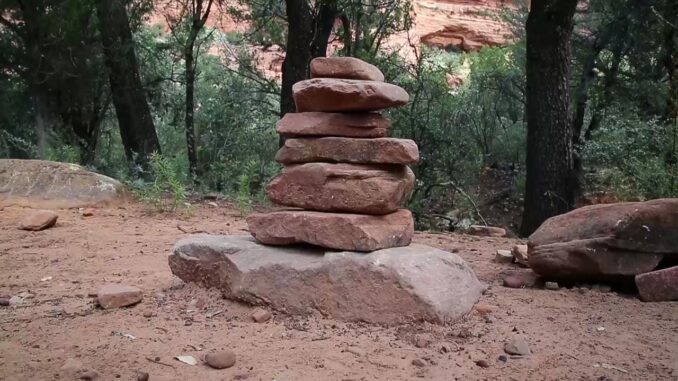
It is not uncommon when hiking in local conservation lands, town forests, and state parks in northeastern United States to discover old stone cairns and stones piles. It is estimated that there over 100,000 just in New England alone. Who built them, when, and why?
The short answer is that cairns have been built over the past 5,000 years in New England by Native Americans for ceremonial purposes, and stones piles have been built over the past 400 years by farmers clearing fields and building stones walls. How do you tell the difference?
Stone cairns are compact mounds of stone built by carefully placing one stone at a time. Each cairn was made for a specific purpose like a boundary marker or Native American ritual cairn. In contrast, stone piles are loose piles of stone created as the result of being dumped from a wagon. They generally exhibit stones scattered around their edges. These piles are a byproduct of field clearing or stone wall building activities.
Clearing rocks from a field is a very labor intensive process. Farmers only cleared fields they intended plow or cut for hay. Fields for pasturing livestock were generally not cleared of stone. The rocks being cleared were thrown in a wagon or onto a heavy duty sled and transported to the edge of the field or to a non farmable spot in the middle of the field and unceremoniously dumped. Loose piles of rock with stone scattered around the edges found along the edges of old farm fields are almost always field clearing stone piles.
Occasionally, you find a series of stone piles placed from 10 to 25 feet apart in a straight line. If you follow this line of piles many times you will come to the end of a stone wall. What you have discovered is a stone wall in the process of being built but never finished. Stone piles placed in a line along side a broken down stone wall generally mean the wall was in the process of being repaired.
If you find a single stone cairn about 2 to 3 feet in diameter with a metal pipe in it or marked by surveyors orange paint, then you have found an old property boundary marker.
If you find a few cairns together in an irregular layout you have found Native American cairns. The cairns may be placed on the ground, on top or against a boulder, or even crammed into a split in the boulder. The cairn may only be a few stones placed on top of a boulder, a small pile on the ground, or a huge cairn with thousands of stones. Stop and look around. You will generally find more of them. What you have found is a Native American ceremonial site. A place where Native Americans came to pray, hold ceremonies, and practice their religion. Think of it as an outdoor church or shrine. We know this because early Christian missionaries and travelers mention in their diaries and letters that their Indian guides would stop and solemnly add a stone to these cairns as a religious observance. In addition, in recent years, both the Narragansett and Wampanoag tribes have publicly stated that these cairn sites were built by their ancestors.
The Native Americans still consider these places sacred to their spiritual beliefs. Please be respectful when exploring cairn sites by not digging, removing or adding stones or artifacts. Instead, take photographs and leave everything as you found it. Photographs are great because you can easily share them with friends and family.
Most of New England with the exception of rocky, sandy, and swamp land was farmed at one point or another in the past 400 years. So it is not uncommon to find a Native American cairn site on old farm land. If the cairns were not in their way most farmers left them untouched out of superstition, curiosity, or even respect. In many cases it was simply easier to graze the cows among the cairns then to remove them. A few of these cairn sites on farms were built during the 1700 and 1800’s. These farms were owned by Native Americans who quietly continued to practice their tradition beliefs out of sight of their Christian neighbors.
Basic Safety
(1) When exploring old farm sites be sure to locate all the wells first and make sure everyone knows where they are especially any children.
(2) Take appropriate precautions against poison ivy and ticks. Both are commonly found when hiking in the woods.
(3) Do not climb on or enter unstable stone structures.
(4) Do not put your hand into any dark space or enter a cave without first checking it with a flash light. Snakes, porcupines, and other creatures like to use these for their dens. If you hear a high pitched steam whistle like sound then you have come too close to a timber rattlesnake.
Unless otherwise stated, PONIREVO and/or its licensors DO NOT own any intellectual property rights in the website and material on the website. Majority of the site’s content has been scraped and auto posted by a third party artificial intelligence program —– PONIREVO Creation Team.
Proudly WWW.PONIREVO.COM



